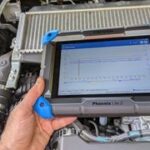The 2013 Honda Accord boasts a comprehensive airbag system designed to maximize occupant protection in the event of a collision. This article delves into the details of the Accord’s airbag technology, highlighting its key features and advancements.
Advanced Airbag Technology in the 2013 Honda Accord
Honda has always prioritized safety, and the 2013 Accord exemplifies this commitment with its advanced airbag system. This system includes multiple airbags strategically placed throughout the cabin to provide comprehensive protection for occupants in various collision scenarios.
Key Features of the 2013 Honda Accord Airbag System:
- Dual-Stage, Multiple-Threshold Front Airbags: These airbags deploy in two stages depending on the severity of the impact, and also adjust inflation rates based on factors like seatbelt usage, helping to minimize the risk of airbag-related injuries.
- SmartVent™ Front Side Airbags: Redesigned for 2013, these side airbags offer enhanced protection for the pelvis and thorax in side impacts. The SmartVent™ technology mitigates the risk of excessive deployment force, eliminating the need for the previous Occupant Position Detection System (OPDS).
- Side Curtain Airbags: These airbags deploy from the roof to protect the heads of outboard occupants in side impacts. The 2013 Accord features a wider deployment profile for these airbags, enhancing ejection mitigation and exceeding safety regulations ahead of their 2015 effective date.
Example of airbag deployment in a 2013 Honda Accord during a crash test.
Passive Safety Features Complementing the Airbag System
The 2013 Accord’s airbag system works in conjunction with other passive safety features to create a robust safety network. These features include:
- Advanced Compatibility Engineering™ (ACE™) Body Structure: This innovative body structure enhances occupant protection and crash compatibility in frontal collisions by distributing crash energy more evenly throughout the vehicle.
- 3-Point Seat Belts with Automatic Tensioning System: These seatbelts help secure occupants in their seats during a collision, working in synergy with the airbag system to minimize injury.
- Front Seat Design for Rear Collision Mitigation: The front seats have been redesigned to help reduce the likelihood of neck injuries in rear-end collisions.
Diagram showcasing the ACE™ body structure of the 2013 Honda Accord.
Projected Safety Ratings for the 2013 Honda Accord
While official results weren’t available at the time of the vehicle’s release, internal testing suggested that the 2013 Accord would achieve top safety ratings from both the National Highway Traffic Safety Administration (NHTSA) and the Insurance Institute for Highway Safety (IIHS). These projections included a 5-Star overall rating from NHTSA and a “Good” rating in various IIHS crash tests.
Honda’s Commitment to Safety
The 2013 Honda Accord’s airbag system reflects Honda’s ongoing dedication to vehicle safety. By combining advanced airbag technology with other passive safety features and a robust body structure, the Accord provides a high level of protection for its occupants.
The 2013 Honda Accord undergoing a crash test to assess its safety performance.
Conclusion
The 2013 Honda Accord’s airbag system is a critical component of its overall safety design. This comprehensive system, combined with other safety features, contributes to the Accord’s strong safety performance and provides drivers and passengers with peace of mind.
